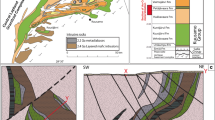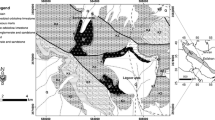Abstract
Petrology and mineral chemistry of ten types of tourmalines from Pb-Zn bearing strata-bound exhalative deposits and Cu-Au-Fe deposits, presumably of IOCG-type, from Rajasthan are presented. The Pb-Zn deposits studied include Agucha, Kayar and Dariba areas in central Rajasthan, each of which is widely separated in space and occurs in isolated but coeval basins within the Archaean basement. The Cu-Au deposits include Ghagri, Bada Talav, Dugocha and Bhukia areas in southeast Rajasthan. The syngenetic Pb-Zn type and the epigenetic Cu-Au-Fe type of deposits are formed during the initial phase of Paleoproterozoic Aravalli Basin evolution with dominant deposition of shelf facies pelite-carbonate sequence of Debari Group. The post-depositional tectono-metamorphic history of the host rocks of Pb-Zn type and Cu-Au type deposits differ significantly with the former deposits showing higher metamorphic impress (amphibolite to lower granulite facies) than the latter (green schist facies).
This study suggests that tourmalines on individual deposit scale exhibit both similarities and differences in optical and chemical features that are in accordance to their bulk host mineral assemblages. But on individual belt-scale, despite significant differences in the post-depositional metamorphic alterations, there is an overall chemical similarity of tourmalines that suggests prevalence of similar hydrothermal conditions during the formation of the tourmalines of individual deposits in each of the Pb-Zn and Cu-Au belts. In many of the discriminant diagrams using the critical elements, the tourmalines of these two belts maintain a distinct identity and assert their role as metal-type indicator in contemporaneous (Paleoproterozoic) deposits formed in different hydrothermal conditions.
This study also tests the reported role of tetrahedral alumina (Aliv) and X-site vacancies (X□) in the tourmaline in indicating the grade of metamorphism of the host rocks. Whereas this study confirms the assertions regarding the covariance of Aliv with respect to the grade of metamorphism in calcareous and metapelitic sediments, the same assertions could not be made in respect of X□ for the tourmalines from different ore deposits of Rajasthan. The latter is attributed to the diffusion of Na+ in the tourmaline structure from the abundantly available Na-rich host rocks (albitites) in a post-ore formation event.
Similar content being viewed by others
References
Bandopadhyay, B.K., Slack, J.F., Palmer, M.R. and Roy A (1993) Tourmalinites associated with stratabound massive sulphide deposits in the Proterozoic Sakoli Group, Nagpur district, Central India: In: Y.T. Maurice (Ed.), Proc. Eight Quad IAGOD Symp., E. Schweizerbart’scheVerlagsbuchhandlung. Stuttgart, pp.867–885.
Barton, M.D. and Johnson, D.A. (1996) An evaporitic-source model for igneous-related Fe-oxide-(REE-Cu-Au-U) mineralization. Geology, v.24, pp.259–262.
Cavarrette, G. and Puxedda, M. (1990) Schorl-dravite-ferridravite tourmalines deposited by hydrothermal magmatic fluids during early evolution of the Larderello geothermal field, Italy. Econ. Geol., v.85, pp.1236–1251.
Choudhury, A.K., Gopalan, K. and Sastry, C.A. (1984) Present status of the geochronology of the Precambrian rocks of Rajasthan. Tectonophysics, v.105, pp.131–140.
Deb, M. (2001) Metallogeny in the Aravalli-Delhi orogenic belt, Northwestern India. Geol. Surv. India, Spec. Publ. No.55, pp.333–350.
Deb, M. (2008) Some key issues of gold metallogeny in India. (Abstract). International. Workshop on “Gold Metallogeny in India”. Delhi University, pp.50–53.
Deb, M. and Pal, T. (2004) Geology and Genesis of the base metal sulphide deposits in the Dariba-Rajpura-Bethumni belt, Rajasthan, India, in the light of basin evolution. In: M. Deb and W.D. Goodfellow (Eds.), Sediment hosted Lead-Zinc Deposits. Narosa Pubulishing House, New Delhi, pp.304–327.
Deb, M. and Thorpe, R.I. (2004) Geochromological constraints in the Precambrian Geology of Rajasthan and their Metallogenic Implications. In: In: M. Deb and W.D. Goodfellow (Eds.), Sediment hosted Lead-Zinc Deposits. Narosa Pubulishing House, New Delhi, pp.304–327
Deb, M. and Sehgal, U. (1997) Petrology, geothermobarometry and C-O-H-S fluid compositions in the environs of Rampura-Agucha Zn-(Pb) ore deposit, Bhilwara District, Rajasthan. Proc. Indian Acad. Sci. (Earth Planet. Sci.), v.106, no.4, pp.343–356.
Deb, M., Thorpe, R.I., Cumming, G.L. and Wagner, P.A. (1989) Age, source and stratigraphic implications of lead isotope data for conformable seiment-hosted base metal deposits in the Proterozoic Aravalli-Delhi orogenic belt, northwestern India. Precambrian Res., v.43, pp.1–22.
Deb, M., Tiwari, A. and Palmer, M.R. (1997) Tourmaline in Proterozoic massive sulphide deposits from Rajasthan, India. Mineral. Deposita, v.32, pp.94–99.
Deer, R.A., Howie, W.A. and Zussmanj (1967) Rock forming minerals. Concise volume. Longman, 592p.
Ethier, V.G. and Campbell, F.A. (1977) Tourmaline concentrations in Proterozoic sediments of the southern Cordillera of Canada and their economic significance. Can Jour. Earth Sci., v.14, pp.2348–2363.
Fareeduddin, Kirmani, I.R. and Davay, D.R. (1997) Gold in Sulfide ores of Rajasthan — A review. Indian Minerals, v.50, no.4, pp.369–376
Fareeduddin and Kroner, A. (1998) Single zircon age constraints on the evolution of the Rajasthan granulites. In: B.S. Paliwal (Ed.), Indian Precambrians. Sci. Publ., New Delhi.
Fareeduddin, Reddy, M. and Bose, U. (1995) Reappraisal of the Delhi stratigraphy in Ajmer-Sambhar sector. Jour. Geol. Soc. India, v.45, pp.667–679.
Gandhi, S.M. (2003) Rampura-Agucha zinc-lead deposit. Mem. Geol. Soc. India, no.55, 154p.
Ghariya, S.S., Rao, K.N. and Jat, R.L. (1998) Keratophyres in the Lower Proterozoics of the Aravalli Fold Belt, Rajasthan India. In: M.S. Krishnan Centenary Commemorative National Seminar volume, 1–2 Nov. 1998, pp 64–66.
Golani, P.R., Pandit, M.K., Sial, A.N., Fallick, A.E., Ferreira, V.P. and Roy, A.B. (2002) B-Na rich Palaeoproterozoic Aravalli metasediments of evaporitic association, NW India: a new repository of gold mineralization. Precambrian Res., v.116, pp.183–198.
Golani, P.R., Rajawat, R.S., Pant, N.C. and Rao, M.S (1999) Mineralogy of gold and associated alloys in sulphides of Bhukia gold prospects in southeastern Rajasthan, Western India. Jour. Geol. Soc. India., v.54, pp.121–128.
Goodfellow, W.D., Lydon, J.W. and Turner, R.J.W. (1993) Geology and genesis of stratiform sediment hosted (SEDEX) Zinc-Lead-Silver sulphide deposits. In: R.V. Kirkham, W.D. Sinclair, R.I. Thorpe and J.M. Duke Eds.), Mineral deposits Modeling. Geol. Assoc. Canada, Spec. Paper, v.40, pp.202–251.
Griffin, W.I., Slack, J.F., Ramsden, A.R., Win, T.T. and Ryan, G. (1996) Trace elements in tourmalines from massive sulfide deposits and tourmalinites: Geochemical controls and exploration applications: Econ. Geol., v.91, pp.756–764.
Grover, A.K. and Verma, R.G. (1993) Gold mineralisation in the Precambrian (Bhukia area) of southeastern Rajasthan — A new discovery. Jour. Geol. Soc. India, v.42, no.3, pp.281–288.
Guha, D.B. (2004) Ore petrography, mineralogy and localization of sulphide-gold mineralization of East-Central Block, Bhukia, Banswara District, Rajasthan. Geol. Surv. India, Spec. Publ., no.72, pp.175–188.
Gupta, S.N., Arora, Y.K., Mathur, R.K., Iqbaluddin., Prasad, B., Sahai, T.N. and Sharma, B. (1997) The Precambrian geology of the Aravalli Region, Southern Rajasthan and Northwestern Gujrat. Mem. Geol. Suv. India, Vol. 123, 262p.
Halder, S.K. (2004) Grade and tonnage relationship in sedimenthosted lead-zinc sulphide deposits of Rajasthan, India. In: M. Deb and W.D. Goodefellow (Eds.), Sediment-hosted lead-zinc sulphide deposits: attributes and models of some major deposits in India, Australia and Canada: Narosa Publishing House, New Delhi, pp.264–272.
Hawthorne, F.C. and Henry, D.J. (1999) Classification of the minerals of the tourmaline group. European Jour. Mineralogy, v.11, pp.201–215.
Henry, D.J A. and Guidotti, C.V. (1985) Tourmalines as a petrogenetic indicator mineral: an example from the staurolitegrade metapelites of NW Maine. Amer. Mineral. v.70, pp.1–15.
Henry, D.J. and Dutrow, B.L. (1996) Metamorphic tourmaline and its petrologic applications. In: E.S. Grew and L.M. Anovitz (Eds.), BORON: Mineralogy, Petrology and Geochemistry. Rev. Mineral., v.33, pp.503–557.
Henry, D.J., Sun, H., Slack, J.F. and Dutrow, B.L. (2008) Tourmaline in meta-evaporites and highly mangesian rocks: perspectives from Namibian tourmalinites. European Jour. Mineralogy, v.20, pp.889–904.
Heron, A.M. (1953) Geology of Central Rajputana. Mem Geol. Surv. India, v.79, 389p.
Holler, W. and Gandhi, S.M (1995) Ag-minerals from the metamorphosed Rampura-Agucha Pb-Zn deposit, Rajasthan, India. Can. Min., v.33, pp.1047–1057.
Mishra, B. (2000) Evolution of the Rajpura-Dariba polymetallic sulfide deposit: constraints from sulphidesulfosalt phase equilibria and fluid inclusion studies. In: M. Deb (Ed.), Crustal Evolution and Metallogeny in the Northwestern Indian Shield. Narosa Publication, New Delhi, pp.347–370.
Mishra, B., Upadhyay, D. and Bernhardt, Heinz-juergen (2006) Metamorphism of the host and associated rocks at the Rajpura-Dariba massive sulfide deposit, Northwestern India. Jour.Asian Earth Sci., v.26, pp.21–37.
Ranawat, P.S. and Sharma, N.K. (1990) Petrology and geochemistry of the Precambrian Pb-Zn deposit Rampura-Agucha, India. In: P.G. Spry and L.T. Bryndxia (Eds.), Regional Metamorphism of Ore Deposits, Verlag, pp.197–227.
Rao, M.S., Fareeduddin, Godhavari, K.S., Suresh Chander and Sisodia, C.P (2004) Carbonaceous meta-exhalites of Shungitic affinity in Paleoproterozoic Aravalli Supergroup, Dugocha area, Dist. Udaipur, Rajasthan. Jour. Geol. Soc. India, v.63.
Roy, A.B. (1988) Stratigraphy and tectonic frame work of Aravalli Mountain Range. In: A.B. Roy (Ed.), Precambrians of the Aravalli Mountain Range. Mem. Geol. Soc. India, no.7, pp.3–32.
Roy, A.B. and Kroner, A (1996) Single zircon evaporation ages constraining the growth of Archean Aravalli Craton., northwestern Indian shield. Geol. Mag., v.133, pp.333–342.
Sinha-Roy, S (2001) Plate tectonic controlled Precambrian metallotects in Rajasthan: Their role in predictive metallogeny. Geol. Surv. India, Spec. Publ., no.72, pp.11–34.
Sinha-Roy, S (1988) Proterozoic Wilson Cycles in Rajasthan. In: A.B. Roy (Ed.), Precambrians of the Aravalli Mountain Range. Mem. Geol. Soc. India, no.7, pp.95–108.
Sisodia, C.P., Chattopadhyay, A.K, Suresh Chander and Malhotra, A.K. (2002) Airborne Geophysical Surveys in the exploration for basemetal and gold — Case studies from Rajastha. Geol. Surv. India, Spec. Publ., no.75, pp.29–36.
Slack, J.F. (1996) Tourmaline associations with hydrothermal ore deposits. In: E.S. Grew and A.M. Anovitz (Eds.), Boron: Mineralogy, petrology and geochemistry. Rev. Minerals.
Slack, J.F (1982) Tourmalines in Appalacian-Caledonian massive sulphide deposits and its exploration significance. Trans. Inst. Min. Metall., v.91,(B), pp.B81–B89
Lack, J.F., Herriman, N., Barnes, R.G. and Plimer, I.R. (1984) Stratiform tourmalinites in metamorphic terrane and their geological significance. Geology, v.12, pp.713–716.
Sugden, T.J., Deb, M. and Windley, B.F. (1990) The tectonic setting of mineralization in the Proterozoic Aravalli-Delhi orogenic belt, NW India. In: S.M. Naqvi (Ed.), Precambrian continental crust and its economic resources. Elsevier, Amsterdam, pp.367–390.
Taylor, B.E. and Slack, J.F. (1984) Tourmalines from Applacian-Caledonian massive sulphide deposits: Textural chemica and isotopic relationships. Econ. Geol., v.79, pp.1703–1726.
Werding, G. and Schreyer, W. (1984) Alkali-free tourmaline in the system MgO-Al2O3-B2O3-SiO2-H2O. Geochim. Cosmochim. Acta, v.48, pp.1331–1344.
Author information
Authors and Affiliations
Consortia
Corresponding author
Rights and permissions
About this article
Cite this article
Fareeduddin, Gupta, S., Golani, P.R. et al. Tourmaline as metallogenic indicator: Examples from paleo-proterozoic Pb-Zn and Cu-Au deposits of Rajasthan. J Geol Soc India 76, 215–243 (2010). https://doi.org/10.1007/s12594-010-0095-8
Received:
Accepted:
Published:
Issue Date:
DOI: https://doi.org/10.1007/s12594-010-0095-8




